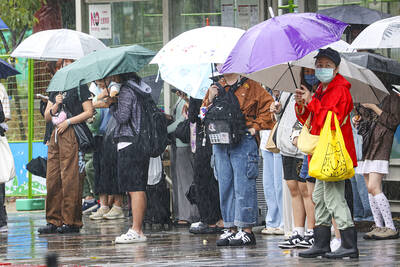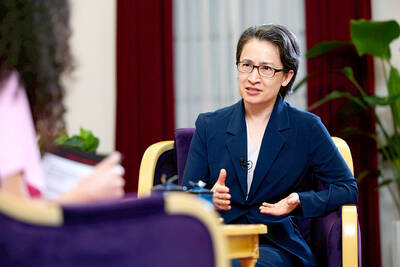The nation’s two World War II-era submarines are undergoing major renovations to upgrade their capabilities, but the Navy and the contractor might dismantle one to gain sub-building experience and study the manufacturing techniques, Minister of National Defense Kao Kuang-chi (高廣圻) said yesterday.
Kao made the remarks in response to questions from legislators yesterday regarding upgrades on the 70-year-old subs.
The upgrades are being undertaken at the Navy’s shipyard and by the China Shipbuilding Corp (CSBC) in Kaohsiung Harbor.
The US-built Hao Si (海獅, sea lion) and Hai Pao (海豹, seal) have been derided as antiques worthy of display in a naval museum.
However, both are still on active duty, a situation that critics contend highlights the nation’s struggle to modernize its submarine fleet, and also accents the navy’s lack of knowledge about new submarine technology.
Kao denied recent news reports that CSBC was looking to cancel its contract for the maintenance and renovation of the subs.
“The work to upgrade the submarines is still ongoing — it was not canceled — but we have to discuss the matter with CSBC to clarify the issues,” Kao said.
The ministry still plans to bolster the navy with new submarines, either purchasing them from foreign nations, or developing an indigenous sub program, he said.
“If we can get assistance and technical support from other nations, then I will support building the submarines ourselves,” Kao said.
Some legislators voiced concern that CSBC lacks experience in the maintenance and repair of submarines and has few qualified technicians, saying that the reassembly of a dismantled sub could be problematic.
Kao replied the major renovations and upgrades are under way, and if CSBC and the naval docks are unable to reassemble the submarines, then one submarine would be refurbished while the other is used to develop insight into the technology involved.
Vice Admiral Shang Jung-chiang (尚永強), assistant chief of staff for logistics at the ministry’s General Staff Headquarters, said CSBC has been reluctant to provide a cost estimate for the tender because of problems with the submarines’ stern and the hull’s oval structure.

Temperatures in northern Taiwan are forecast to reach as high as 30°C today, as an ongoing northeasterly seasonal wind system weakens, the Central Weather Administration (CWA) said. CWA forecaster Tseng Chao-cheng (曾昭誠) said yesterday that with the seasonal wind system weakening, warmer easterly winds would boost the temperature today. Daytime temperatures in northern Taiwan and Yilan County are expected to range from 28°C to 30°C today, up about 3°C from yesterday, Tseng said. According to the CWA, temperature highs in central and southern Taiwan could stay stable. However, the weather is expected to turn cooler starting tonight as the northeasterly wind system strengthens again

The Ministry of Foreign Affairs (MOFA) yesterday expressed “grave concerns” after Singaporean Prime Minister Lawrence Wong (黃循財) reiterated the city-state’s opposition to “Taiwanese independence” during a meeting with Chinese Premier Li Qiang (李強). In Singapore on Saturday, Wong and Li discussed cross-strait developments, the Singaporean Ministry of Foreign Affairs said in a statement. “Prime Minister Wong reiterated that Singapore has a clear and consistent ‘one China’ policy and is opposed to Taiwan independence,” it said. MOFA responded that it is an objective fact and a common understanding shared by many that the Republic of China (ROC) is an independent, sovereign nation, with world-leading

COOLING OFF: Temperatures are expected to fall to lows of about 20°C on Sunday and possibly 18°C to 19°C next week, following a wave of northeasterly winds on Friday The Central Weather Administration (CWA) on Sunday forecast more rain and cooler temperatures for northern Taiwan this week, with the mercury dropping to lows of 18°C, as another wave of northeasterly winds sweeps across the country. The current northeasterly winds would continue to affect Taiwan through today, with precipitation peaking today, bringing increased rainfall to windward areas, CWA forecaster Liu Pei-teng (劉沛滕) said. The weather system would weaken slightly tomorrow before another, stronger wave arrives on Friday, lasting into next week, Liu said. From yesterday to today, northern Taiwan can expect cool, wet weather, with lows of 22°C to 23°C in most areas,

DEFENDING FREEDOM: Taiwanese love peace and helping others, and hope to be a positive force in the world, Vice President Hsiao Bi-khim told ‘Weltspiegel’ Taiwan is making every effort to prevent war in the face of China’s hybrid coercion tactics and military threats, Vice President Hsiao Bi-khim (蕭美琴) said in an interview with German public broadcaster ARD’s program Weltspiegel that aired on Monday. Taiwan is not seeking provocation or intending to disrupt international order, but “must possess the capacity for self-defense,” a news release issued by the Presidential Office yesterday quoted her as saying. Taiwan is closely watching not only the increasing scope and frequency of Chinese military exercises around the nation, but also Beijing’s hybrid and cognitive warfare tactics, including manipulating public opinion, fostering